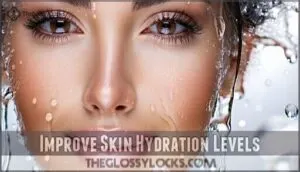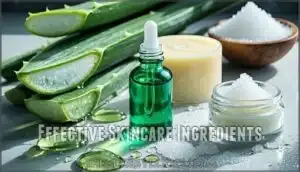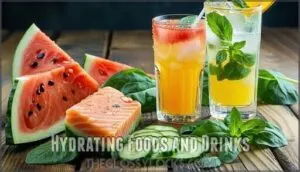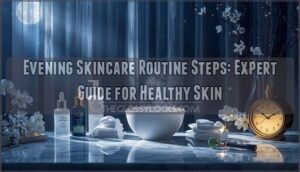This site is supported by our readers. We may earn a commission, at no cost to you, if you purchase through links.
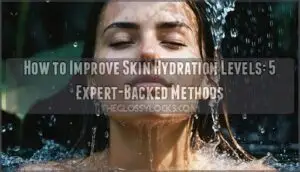
Use a gentle cleanser that won’t strip your skin’s natural oils, then apply moisturizer to damp skin within three minutes of washing. Look for ingredients like hyaluronic acid and glycerin that pull moisture into your cells, followed by ceramides or petrolatum to seal it in.
Don’t forget a humidifier during dry months and lukewarm showers instead of scalding hot ones. The secret lies in understanding which specific ingredients work best for your unique skin type, using the right approach for optimal skin hydration.
Table Of Contents
- Key Takeaways
- Skin Hydration Basics
- Improve Skin Hydration Levels
- External Hydration Methods
- Effective Skincare Ingredients
- Lifestyle and Dietary Changes
- Frequently Asked Questions (FAQs)
- How to keep your skin hydrated?
- Does drinking more water hydrate your skin?
- Why does your skin need hydration?
- Is skin hydration easy?
- How do you keep your skin hydrated during dry months?
- What products should I use to hydrate my skin?
- How to improve hydration skin?
- What promotes skin hydration?
- What is the fastest way to fix dehydrated skin?
- How long does it take for hydration to improve skin?
- Conclusion
Key Takeaways
- Combine internal and external hydration strategies – You’ll get the best results when you drink adequate water and eat hydrating foods while also using topical moisturizers with ingredients like hyaluronic acid and ceramides that work together like a one-two punch.
- Apply moisturizer to damp skin within three minutes of washing – This technique locks in residual moisture when your skin’s most receptive, and you should use lukewarm water instead of hot showers to prevent stripping your skin’s natural oils.
- Layer your skincare products strategically – You’ll want to apply humectants like hyaluronic acid first to pull moisture into your skin, then follow with emollients and occlusives like ceramides or petrolatum to seal it in and prevent water loss.
- Focus on consistency over expensive products – You don’t need miracle creams to see results; instead, you’ll notice visible improvements within 2-4 weeks by maintaining daily habits like gentle cleansing, proper moisturizing, and using a humidifier during dry months.
Skin Hydration Basics
Your skin’s hydration needs aren’t as straightforward as you might think, since dehydrated skin lacks water while dry skin lacks oil, requiring completely different treatment approaches.
Understanding these distinctions, along with how your skin’s three layers work together to maintain its protective barrier, will help you choose the most effective hydration strategies for your specific skin concerns.
Dehydrated Vs Dry Skin
Think of your skin as a sponge that needs both water and oil to stay healthy. Identifying Dehydration means recognizing when your skin hydration drops, causing tightness and dullness. Dry skin lacks natural oils, while dehydrated skin lacks water.
Your skin is like a thirsty sponge—it needs both water and oil to stay plump and healthy.
Your skin type determines the best approach for treating dryness and restoring your skin barrier.
Understanding the key differences:
- Dehydrated skin feels tight and may show fine lines that disappear with proper skin moisture
- Dry skin appears flaky, rough, and produces less natural oil than normal
- Combined skin can experience both conditions simultaneously, requiring targeted treatment
- Causes differences include genetics for dryness versus lifestyle factors for dehydration
- Proper identification helps you choose between water-based or oil-based solutions
Skin Layers and Functions
Your skin operates like a three-story building, each layer serving distinct purposes for ideal skin hydration levels.
The epidermis handles continuous shedding while melanocytes control pigmentation.
Below, dermis receptors detect touch and pain, providing structural strength.
The deepest hypodermis insulation layer acts as your body’s shock absorber, conserving heat and protecting essential organs underneath.
Importance of Hydration
Beyond surface-level benefits, proper skin hydration levels serve as your body’s first line of defense.
When you hydrate skin effectively, you’re supporting barrier function that protects against environmental damage while promoting cellular health and skin elasticity.
Here’s why moisturizing skin matters for overall wellness:
- Barrier Protection – Maintains your skin’s natural shield against pollutants and bacteria
- Cellular Function – Supports healthy cell turnover and repair processes throughout skin layers
- Systemic Balance – Complements water intake for thorough hydration from inside out
- Aging Prevention – Preserves elasticity and reduces premature wrinkle formation over time
Improve Skin Hydration Levels
Your skin’s hydration journey extends beyond surface-level moisture.
True hydration starts from within—your skin’s deepest layers need attention, not just the surface.
While understanding the basics sets the foundation, implementing effective hydration strategies transforms your skin’s health from the inside out.
Cellular hydration plays a pivotal role in how your skin maintains its plump, healthy appearance.
This process involves ensuring water reaches deep into skin cells, not just sitting on the surface.
Modern hydration strategies combine multiple approaches for maximum effectiveness.
Sleeping masks work overnight to deliver concentrated moisture while you rest.
Thermal sprays provide instant hydration boosts throughout the day, especially helpful in dry environments.
Even your makeup routine can contribute to skin hydration when you choose products containing hyaluronic acid and other moisture-binding ingredients.
The key lies in addressing hydration at every level.
Your skin barrier requires consistent support to prevent water loss, while moisturizing skin becomes more effective when you target both surface and deeper cellular needs, ensuring effective hydration strategies and maintaining a healthy appearance with cellular hydration and using thermal sprays for instant boosts.
External Hydration Methods
You can’t moisturize your skin from the inside out with water alone, which is why external hydration methods become essential for maintaining healthy, supple skin.
These topical approaches work by creating barriers that prevent water loss, adding moisture directly to your skin’s surface, and optimizing your environment to support natural hydration processes.
Showering and Bathing Techniques
Water temperature plays a bigger role in skin health than most people realize.
Hot water strips away your skin’s natural oils, leading to increased water loss and irritation.
Here’s how to shower for healthier, more hydrated skin:
- Keep showers short and sweet – Limit bathing to 5-10 minutes to prevent overcleansing and preserve your skin’s protective barrier
- Choose lukewarm over steaming – Hot water may feel relaxing, but it damages your skin’s moisture barrier and worsens dry skin conditions
- Pat, don’t rub – Aggressive towel drying creates micro-tears in your skin’s surface, so gently pat yourself dry instead
- Skip harsh cleansers – Foaming and antibacterial soaps strip essential oils, leaving your skin vulnerable to dehydration
- Apply moisturizer immediately – Post-shower moisturizing within 2-3 minutes locks in residual moisture while your skin is still damp
Bath oils can provide extra hydration, but avoid soaking too long.
Your cleansing frequency should match your skin type – daily washing isn’t necessary for everyone and can contribute to water loss.
Humidifiers and Air Humidity
Indoor air acts like a moisture thief, stealing hydration from your skin’s surface.
A humidifier becomes your ally, maintaining ideal humidity levels between 30-50% to prevent water loss.
Different humidifier types offer varying benefits for dry skin and dehydrated skin conditions.
Regular maintenance guarantees clean operation while protecting against external elements that compromise your skin’s natural barrier function.
Gentle Cleansers and Moisturizers
After cleansing, your skin barrier needs gentle care to maintain its protective function.
Choose mild cleansers without harsh sulfates that strip natural oils, then follow with ceramide-rich moisturizers to lock in hydration.
Consider these gentle cleanser ingredients and moisturizer types for sensitive skin:
- Cream cleansers with glycerin for barrier repair
- Hydrating serums before moisturizer application
- Ceramide moisturizers for overnight protection
- Oil-based cleansers for makeup removal.
These products often contain helpful glycerin.
Exfoliation and Skin Barrier
Regular exfoliation removes dead skin cells that block moisturizer absorption, but overdoing it damages your skin barrier and increases transepidermal water loss.
Chemical exfoliants like AHAs work gentler than physical exfoliation methods.
Limit exfoliation frequency to once weekly for sensitive skin, twice for oily types.
Post-exfoliation care with ceramides restores natural moisturizing factors and prevents barrier damage.
Effective Skincare Ingredients
You can’t simply slap any moisturizer on your face and expect lasting hydration—the specific ingredients in your skincare products make all the difference.
Understanding which compounds actually pull moisture into your skin, lock it in place, and strengthen your natural barrier will transform your skincare routine from guesswork into targeted science.
Humectants and Emollients
Think of humectants as your skin’s personal water magnets.
Hyaluronic acid and glycerin pull moisture from the air, while emollients like ceramides smooth and soften your skin’s surface.
These ingredient combinations work together in product formulation to maximize skin barrier repair.
Your moisturizer becomes more effective when humectant mechanisms and emollient benefits team up for ideal hydration.
Occlusives and Sunscreen
Occlusives create a protective seal over your skin, preventing transepidermal water loss like a waterproof jacket.
Petrolatum, beeswax, and mineral oil form this hydration barrier effectively.
Sunscreen application serves double duty – broad-spectrum formulas with zinc oxide or titanium dioxide protect while locking moisture in.
Many users find relief using various occlusive products.
Product layering matters: apply lighter serums first, then heavier occlusives and sunscreen last for maximum skin barrier protection.
Hyaluronic Acid and Glycerin
Two powerful humectants deserve your attention for achieving ideal skin hydration. Hyaluronic acid holds up to 1,000 times its weight in water, delivering exceptional skin plumpness benefits.
You can find a quality hyaluronic acid serum for enhanced hydration.
- HA Benefits: Provides deep hydration and reduces fine lines
- Glycerin Benefits: Penetrates deeper than hyaluronic acid, suits all skin types
- Product Combinations: Layer serums under moisturizers for maximum effectiveness
- Application Methods: Apply to damp skin for enhanced absorption
- Skin Types: Both ingredients work universally across different complexions
Ceramides and Fatty Acids
Your skin’s lipid barrier acts like mortar between bricks, with ceramides and fatty acids forming the essential "glue."
These powerhouse ingredients work together to lock in moisture and strengthen your skin’s natural defenses.
Ceramide cream helps restore what time and environmental damage steal away, making skin repair and moisture retention dramatically more effective.
| Component | Primary Function | Skin Benefits |
|---|---|---|
| Ceramides 1-3 | Barrier formation | Prevents water loss, improves texture |
| Ceramides 4-6 | Cell binding | Enhances skin barrier function, reduces irritation |
| Free Fatty Acids | Moisture sealing | Maintains pH balance, supports healing |
| Cholesterol | Membrane stability | Strengthens protective barrier, aids repair |
| Sphingosine | Cell communication | Promotes healthy cell turnover, reduces inflammation |
Lifestyle and Dietary Changes
You can’t simply drink your way to hydrated skin, since what you eat and how you live affects your body’s water balance just as much as your skincare routine.
Your dietary choices, from omega-3 rich foods to limiting alcohol and caffeine, directly impact your skin’s ability to retain moisture and maintain its protective barrier.
Hydrating Foods and Drinks
Your plate can be your skin’s best friend when loaded with water-rich foods like watermelon, cucumbers, and spinach.
These antioxidant-rich foods boost hydration from within while healthy fats from salmon provide omega-3 fatty acids that strengthen your moisture barrier.
Pair plain water with electrolyte drinks throughout the day, timing your hydration consistently for peak cellular function.
Limiting Dehydrating Substances
Cut back on dehydrating drinks like alcohol and coffee that pull moisture from your skin cells.
Alcohols Impact includes disrupting your skin’s natural barrier, while Caffeine Concerns involve increased water loss.
Processed Foods loaded with sodium and sugars also work against hydration goals.
Sodium Effects include fluid retention issues, and Sugars Role involves inflammation that compromises your skin’s moisture balance, highlighting the importance of avoiding these to maintain healthy skin, with Alcohols Impact being a key factor.
Healthy Fats and Omega-3s
While cutting back on dehydrating substances helps, adding the right nutrients supercharges your skin’s moisture retention.
Omega-3 fatty acids from salmon, walnuts, and flaxseeds strengthen your skin barrier like reinforcing a leaky roof.
These healthy fats reduce inflammation while boosting cellular hydration from within, and your dehydrated skin craves these essential building blocks for improved elasticity and lasting moisture, which can help with moisture retention and provide lasting moisture.
Zinc and Vitamin C for Skin Health
Beyond healthy fats, zinc benefits and vitamin C sources work as your skin’s repair crew.
Zinc regulates oil production while supporting collagen production, and vitamin C’s antioxidant properties shield against damage.
Together, they strengthen your skin’s barrier function and boost skin repair processes, think of them as your hydration’s bodyguards, protecting moisture levels while promoting overall skin health through their powerful antioxidant action and supporting collagen production.
Frequently Asked Questions (FAQs)
How to keep your skin hydrated?
Your skin’s outermost layer contains 30% water, making hydration essential.
Use lukewarm showers, apply moisturizer to damp skin, drink plenty of water, and choose products with hyaluronic acid for the best results.
Does drinking more water hydrate your skin?
Drinking water helps maintain your skin’s barrier function, but it’s not enough alone. Your skin needs topical moisturizers, healthy fats, and proper skincare to truly stay hydrated and plump.
Why does your skin need hydration?
Your skin’s barrier needs hydration to shield against environmental damage, irritants, and bacteria. Well-hydrated skin maintains elasticity, prevents premature aging, and supports cellular repair while keeping you comfortable and healthy-looking.
Is skin hydration easy?
Yes, achieving proper skin hydration is surprisingly straightforward once you understand the basics.
You’ll need consistent daily habits, quality products with the right ingredients, and patience as your skin barrier repairs itself.
How do you keep your skin hydrated during dry months?
Use a humidifier to add moisture to indoor air, switch to lukewarm showers, apply moisturizer on damp skin, and choose heavier creams with ceramides and hyaluronic acid for overnight protection.
What products should I use to hydrate my skin?
Forget expensive miracle creams promising fountain-of-youth results.
You’ll want gentle cleansers, hyaluronic acid serums, ceramide moisturizers, and broad-spectrum sunscreen.
Layer humectants like glycerin under emollient-rich creams.
Your wallet and complexion will thank you.
How to improve hydration skin?
Apply moisturizer to damp skin, use gentle cleansers, drink water regularly, and incorporate hydrating ingredients like hyaluronic acid.
Short lukewarm showers, humidifiers, and omega-3 rich foods also boost your skin’s moisture levels effectively.
What promotes skin hydration?
Like knights of old donning armor for battle, you’ll want to layer humectants, emollients, and occlusives.
Hyaluronic acid pulls moisture in, ceramides lock it down, while drinking water and eating omega-rich foods fuel hydration from within.
What is the fastest way to fix dehydrated skin?
Drink water immediately, then apply hyaluronic acid serum to damp skin followed by a heavy moisturizer.
Add a humidifier to your room and avoid hot showers.
You’ll see improvement within 24-48 hours.
How long does it take for hydration to improve skin?
Coincidentally, your skin’s hydration timeline mirrors your body’s natural renewal cycle.
You’ll notice initial improvements within 24-48 hours, but significant changes typically take 2-4 weeks as your skin barrier rebuilds and strengthens.
Conclusion
Achieving ideal skin hydration isn’t just about slathering on more cream—it’s a strategic combination of internal and external approaches.
By drinking adequate water, choosing gentle cleansers, applying moisturizer to damp skin, and incorporating ingredients like hyaluronic acid and ceramides, you’ll notice visible improvements within weeks.
Remember that consistency matters more than expensive products, and when you learn how to improve skin hydration levels through these proven methods, you’re investing in healthier, more resilient skin for years to come.
- https://us.caudalie.com/articles-vinohydra/skin-hydration
- https://www.healthline.com/health/beauty-skin-care/better-skin-in-3-days
- https://www.botanicalscience.net/everything-you-need-to-know-about-skin-hydration/
- https://spadaspa.com/drinking-water-wont-hydrate-your-skin-heres-what-will/
- https://www.webmd.com/beauty/features/skin-hydration

